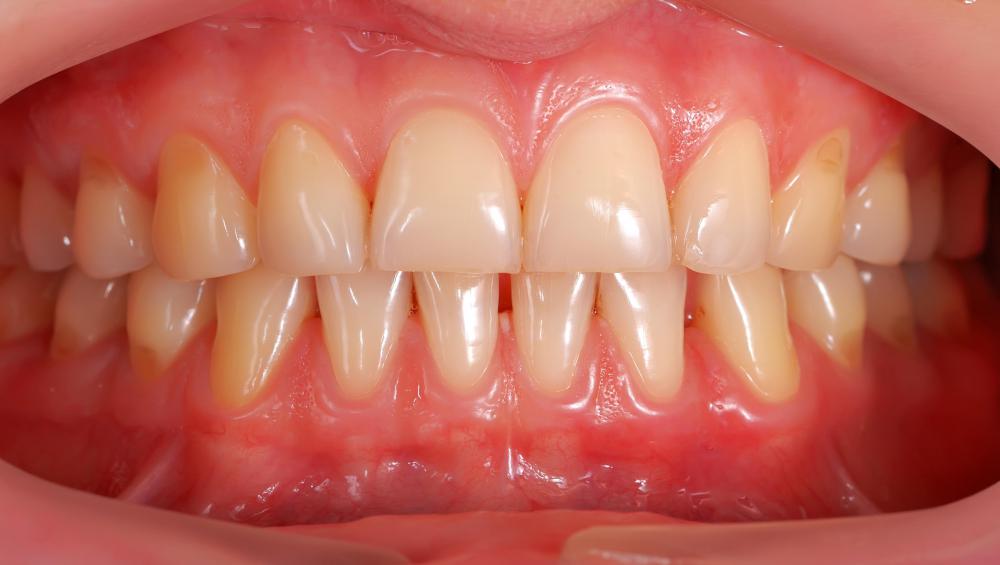At WiseGEEK, we're committed to delivering accurate, trustworthy information. Our expert-authored content is rigorously fact-checked and sourced from credible authorities. Discover how we uphold the highest standards in providing you with reliable knowledge.
What Is Gingival Crevicular Fluid?
Gingival crevicular fluid is an exudate secreted by the gums that can be found in the crevices located at the point where the gum line meets the teeth. Concentrations of this fluid are usually low, but can spike when an inflammatory process occurs in the mouth. Patients with active gum disease tend to have more gingival crevicular fluid, and research on this body fluid suggests that testing during periods of active inflammation can provide important and useful information about the outbreak.
Mucous membranes in the body like the gingiva produce fluids as lubricants, to keep their surfaces hydrated. In the mouth, the warm, moist environment heals quickly from small injuries but can also become a breeding ground for bacteria. Gingival crevicular fluid can play a key role in this, by creating a fluid suspension that may support bacterial colonies in the mouth, including colonies of anaerobes that normally would not thrive in this environment because of the oxygen levels.

Samples taken from a patient can contain bacteria, particles of food, waste products of bacterial digestion, and varying levels of compounds produced by the body in response to inflammation. The composition of the fluid can provide information about the nature of the inflammation and how far it has progressed. This information can potentially be beneficial for care providers, who want to develop a treatment plan appropriate to the needs of the patient. Samples are easy to collect with a small swab or probing tool.

As inflammation declines, the level of gingival crevicular fluid should decrease and stabilize at a more normal and appropriate amount to keep the mouth lubricated and healthy. In patients with very dry mouths, the mucous membranes may fail to meet the lubrication needs of the mouth, and this can result in cracked lips and tongue along with other symptoms, like cotton mouth. These patients may need to use specially formulated mouthwashes to address the shortage of natural lubrication.

Patients with diabetes need to be particularly careful with their gingival crevicular fluid, as the fluid contains high glucose levels when their blood sugar is poorly controlled. This can provide food for bacteria, and may exacerbate periodontal disease. Gum disease in diabetic patients can be a serious problem, as such patients tend to heal more slowly from wounds and may be more vulnerable to complications like septicemia, where bacteria enter the bloodstream through lesions in the mouth. These patients need to exercise excellent oral hygiene to protect their health.
AS FEATURED ON:
AS FEATURED ON:














Discussion Comments
I have had diabetes for many years, and it is a constant struggle to keep my glucose levels under control.
Diabetes is something that affects many areas of the body including your teeth and gums. If my blood sugar levels are constantly high, this even shows up in the fluid in my mouth.
I also have a dry mouth and always feel thirsty. For me this is a usually a sign that I need to keep things under better control.
If my dentist tells me that the crevicular fluid levels in my mouth are high, I know I need to work harder at keeping my blood sugar level.
I never used to be very faithful at flossing my teeth. A few days before my dentist appointment, I would attempt to floss them, but my dentist could still tell I didn't do this very often.
When he checked my teeth, I had the beginning of periodontal disease and my gums would bleed very easily. My dentist said the most helpful thing I could do was to floss at least once a day, and twice a day would be even better.
It is hard to teach an old dog new tricks, but I added the flossing to my routine every day. My gums are now much healthier. They don't bleed now every time I floss because they are not inflamed all the time.
Now when I go for my dental checkups and he checks my crevicular fluid, my concentrations are in the normal range.
Post your comments